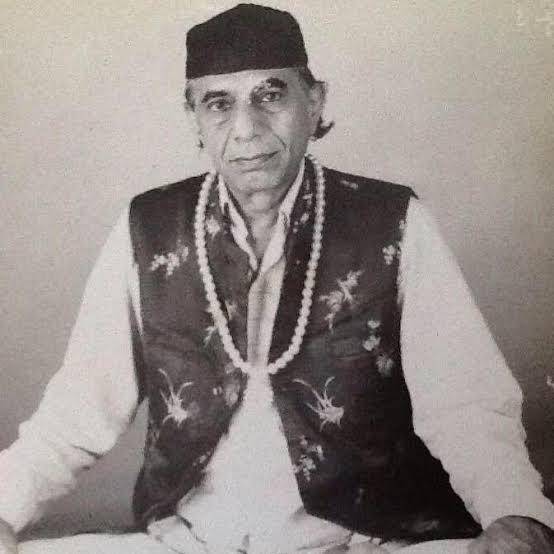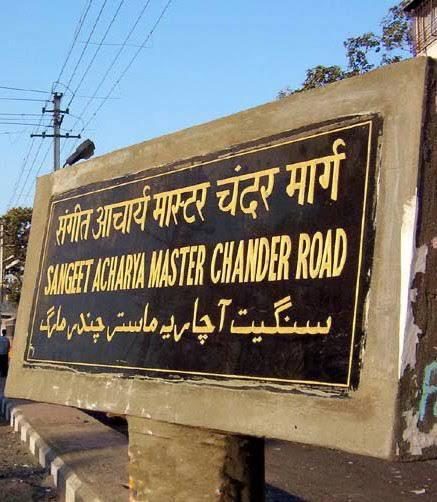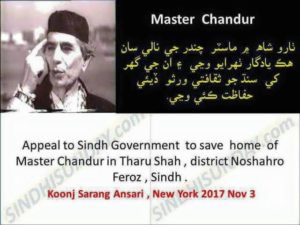
Master Chander’s original name Chandu Nal Damowani. He was born on 7th December 1907, in Tharu Shah, Naushahro Feroze District, Sindh and died on 3rd November 1984. He was a singer and musical director who rendered hundreds of Sindhi songs. During the 1947 partition, Master Chander and the majority of Sindhi Hindus left their homes and properties in Sindh. He narrowly escaped his own death during those tumultuous days, having sent his family- his pregnant wife, Heti, mother, three sons and three daughters, as well as extended family members ahead in a ship to Bombay. Seeing the plight of his people and missing his homeland, he began to write and sing songs about giving confidence to the displaced Hindu Sindhis in India, some of the notable songs during this period were "Mitha Abana."
 He was an only child whose early education took place in Tharu shah, in today's Naushahro Feroze District. In his family singing was not encouraged but Master Chander had a passion for music and learned the notes of classical music. He used to write lyrics and compose them in classical and folk tunes. Though his parents restricted him he continued his passion for music until he started singing in drawing rooms, orchards and parties.
He was an only child whose early education took place in Tharu shah, in today's Naushahro Feroze District. In his family singing was not encouraged but Master Chander had a passion for music and learned the notes of classical music. He used to write lyrics and compose them in classical and folk tunes. Though his parents restricted him he continued his passion for music until he started singing in drawing rooms, orchards and parties.
He worked in public works department at Nawabshah. During his job at Karachi he opened many schools for music where he used to train music lovers which is why he is known as Master Chander. He faced great odds in acquiring rightful place in the field of music in Sindh. Among his music teachers were Jeevat Ram Mitai, Khan Sahab Barrey Ghulam Ali Khan, Khan Sahab Ashiq and others.
Chander introduced new trends in music. He was first to sing kalam and songs related to love in Sindhi language. His listeners and admirers forgot themselves on the tunes of his singing. He recorded many ghazals and geets for Sindhi and Urdu movies on gramophone.
He recorded his first song “Suhina arz aaahe” in 1932. There must be thousands of songs sung by master Chander but information is available on 400 only. “Rutha e rahan par hujan hayati” (let them live long even when they are not on good terms) is one of his popular rendering.
 One day Bhagat Kanwar Raam, a great singer himself, saw him while singing and predicted that he would become a great singer in the future and will shine like moon.
One day Bhagat Kanwar Raam, a great singer himself, saw him while singing and predicted that he would become a great singer in the future and will shine like moon.
Master Chander also took part as an actor in Indian Sindhi Film “Abana” in 1958. Besides he also performed in various films like “Dilaram” and “Mout ka toofan”, in which he played as hero. He was also selected for “Achoot Kanhaya” with Devika Rani but later on he was replaced by Ashok Kumar. Many of his fans used to spend millions of rupees and gold for watching his concert.
After partition of the subcontinent, he migrated from Sindh to India and lived in Calcutta now known as Kolkata. He performed throughout the world. His songs are still broadcast by All India Radio Delhi.
Master Chander's career spanned over 50 years. His Master's Voice Company awarded Chander several gold medals. In addition, the Sindhi Panchayats & Associations in India & abroad honoured him with medals, trophies, and other tokens of respect and recognition. The last of these honours was presented in 1982 by ‘International Sindhi’ at Birla Matoshri Hall, Mumbai.
 He was an only child whose early education took place in Tharu shah, in today's Naushahro Feroze District. In his family singing was not encouraged but Master Chander had a passion for music and learned the notes of classical music. He used to write lyrics and compose them in classical and folk tunes. Though his parents restricted him he continued his passion for music until he started singing in drawing rooms, orchards and parties.
He was an only child whose early education took place in Tharu shah, in today's Naushahro Feroze District. In his family singing was not encouraged but Master Chander had a passion for music and learned the notes of classical music. He used to write lyrics and compose them in classical and folk tunes. Though his parents restricted him he continued his passion for music until he started singing in drawing rooms, orchards and parties.He worked in public works department at Nawabshah. During his job at Karachi he opened many schools for music where he used to train music lovers which is why he is known as Master Chander. He faced great odds in acquiring rightful place in the field of music in Sindh. Among his music teachers were Jeevat Ram Mitai, Khan Sahab Barrey Ghulam Ali Khan, Khan Sahab Ashiq and others.
Chander introduced new trends in music. He was first to sing kalam and songs related to love in Sindhi language. His listeners and admirers forgot themselves on the tunes of his singing. He recorded many ghazals and geets for Sindhi and Urdu movies on gramophone.
He recorded his first song “Suhina arz aaahe” in 1932. There must be thousands of songs sung by master Chander but information is available on 400 only. “Rutha e rahan par hujan hayati” (let them live long even when they are not on good terms) is one of his popular rendering.
 One day Bhagat Kanwar Raam, a great singer himself, saw him while singing and predicted that he would become a great singer in the future and will shine like moon.
One day Bhagat Kanwar Raam, a great singer himself, saw him while singing and predicted that he would become a great singer in the future and will shine like moon.Master Chander also took part as an actor in Indian Sindhi Film “Abana” in 1958. Besides he also performed in various films like “Dilaram” and “Mout ka toofan”, in which he played as hero. He was also selected for “Achoot Kanhaya” with Devika Rani but later on he was replaced by Ashok Kumar. Many of his fans used to spend millions of rupees and gold for watching his concert.
After partition of the subcontinent, he migrated from Sindh to India and lived in Calcutta now known as Kolkata. He performed throughout the world. His songs are still broadcast by All India Radio Delhi.
Master Chander's career spanned over 50 years. His Master's Voice Company awarded Chander several gold medals. In addition, the Sindhi Panchayats & Associations in India & abroad honoured him with medals, trophies, and other tokens of respect and recognition. The last of these honours was presented in 1982 by ‘International Sindhi’ at Birla Matoshri Hall, Mumbai.
